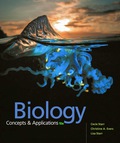
EBK BIOLOGY: CONCEPTS AND APPLICATIONS
10th Edition
ISBN: 8220103600774
Author: STARR
Publisher: CENGAGE L
expand_more
expand_more
format_list_bulleted
Concept explainers
Question
Chapter 17, Problem 4CT
Summary Introduction
To determine:
The ways in which the hypothesis saying that some human traits may have arisen by sexual selection can be tested.
Introduction:
Species of all the organisms have evolved themselves from time to time, according to their needs and changing natural environment around them. Different species adopt different modes of evolution. Natural selection is also one of the evolutionary modes that work on a population with a larger size. Sexual selection is one type of natural selection where individuals of a species prefer to mate with a partner of their desire who has certain special characteristics.
Expert Solution & Answer
Want to see the full answer?
Check out a sample textbook solution
Students have asked these similar questions
What is the difference between Uniporters, Symporters and Antiporters? Which of these are examples of active transport?
What are coupled transporters?
What are “domains” and how do they aid in protein function?
Chapter 17 Solutions
EBK BIOLOGY: CONCEPTS AND APPLICATIONS
Ch. 17 - _________is the original source of new alleles. a....Ch. 17 - Prob. 2SACh. 17 - Match the modes of natural selection with their...Ch. 17 - Prob. 4SACh. 17 - The persistence of the sickle allele at high...Ch. 17 - Prob. 6SACh. 17 - Prob. 7SACh. 17 - Which of the following is not part of how we...Ch. 17 - Prob. 9SACh. 17 - Prob. 10SA
Ch. 17 - Prob. 11SACh. 17 - Prob. 12SACh. 17 - In evolutionary trees, each node represents an...Ch. 17 - Match the evolutionary concepts. ____gene flow a....Ch. 17 - The evolution of wings helped the insect clade to...Ch. 17 - Species have traditionally been characterized as...Ch. 17 - Rama the cama, a llama-camel hybrid, was born in...Ch. 17 - Two species of antelope, one from Africa, the...Ch. 17 - Prob. 4CT
Knowledge Booster
Learn more about
Need a deep-dive on the concept behind this application? Look no further. Learn more about this topic, biology and related others by exploring similar questions and additional content below.Similar questions
- What are intrinsically disordered proteins, and how might they be useful for a living system?arrow_forwardWhat are Amyloid Fibrils? What biological functions are these known to perform?arrow_forwardHow do histamine and prostaglandins help in the mobilization of leukocytes to an injury site? What are chemotactic factors? How do they affect inflammation process?arrow_forward
- Compare and contrast neutrophils and macrophages. Describe two ways they are different and two ways they are similar.arrow_forwardDescribe the effects of three cytokines (not involved in the initial inflammation response). What cells release them?arrow_forwardDescribe activation of helper T cells or cytotoxic T cellsarrow_forward
- Compare and contrast MHC 1 and MHC 2. Describe two way they are different and two ways they similar including how they are used in antigen presentation.arrow_forwardDescribe two antimicrobial properties of the skin.arrow_forwardDescribe how the inflammation response starts including the sentinel cells and the chemicals involved. How do pathogens trigger the response particularly in the skin?arrow_forward
- How does complement promote the immune response? Describe three waysarrow_forwardWhich of the following is not a possible mechanism for autoimmunity? Select one: A. Abnormal expression of MHC II molecules in non-antigen-presenting cells B. Activation of polyclonal B cells C. Polymorphism of HLA alleles D. Molecular mimicry E. Release of sequestered antigensarrow_forwardWRITTEN WORK 3: NON-MENDELIAN GENETICS Part A: Complete the Punnett square and calculate for the probability of genotype and phenotype. i i Genotype: Phenotype: 08:55arrow_forward
arrow_back_ios
SEE MORE QUESTIONS
arrow_forward_ios
Recommended textbooks for you
 Biology Today and Tomorrow without Physiology (Mi...BiologyISBN:9781305117396Author:Cecie Starr, Christine Evers, Lisa StarrPublisher:Cengage Learning
Biology Today and Tomorrow without Physiology (Mi...BiologyISBN:9781305117396Author:Cecie Starr, Christine Evers, Lisa StarrPublisher:Cengage Learning

Biology Today and Tomorrow without Physiology (Mi...
Biology
ISBN:9781305117396
Author:Cecie Starr, Christine Evers, Lisa Starr
Publisher:Cengage Learning